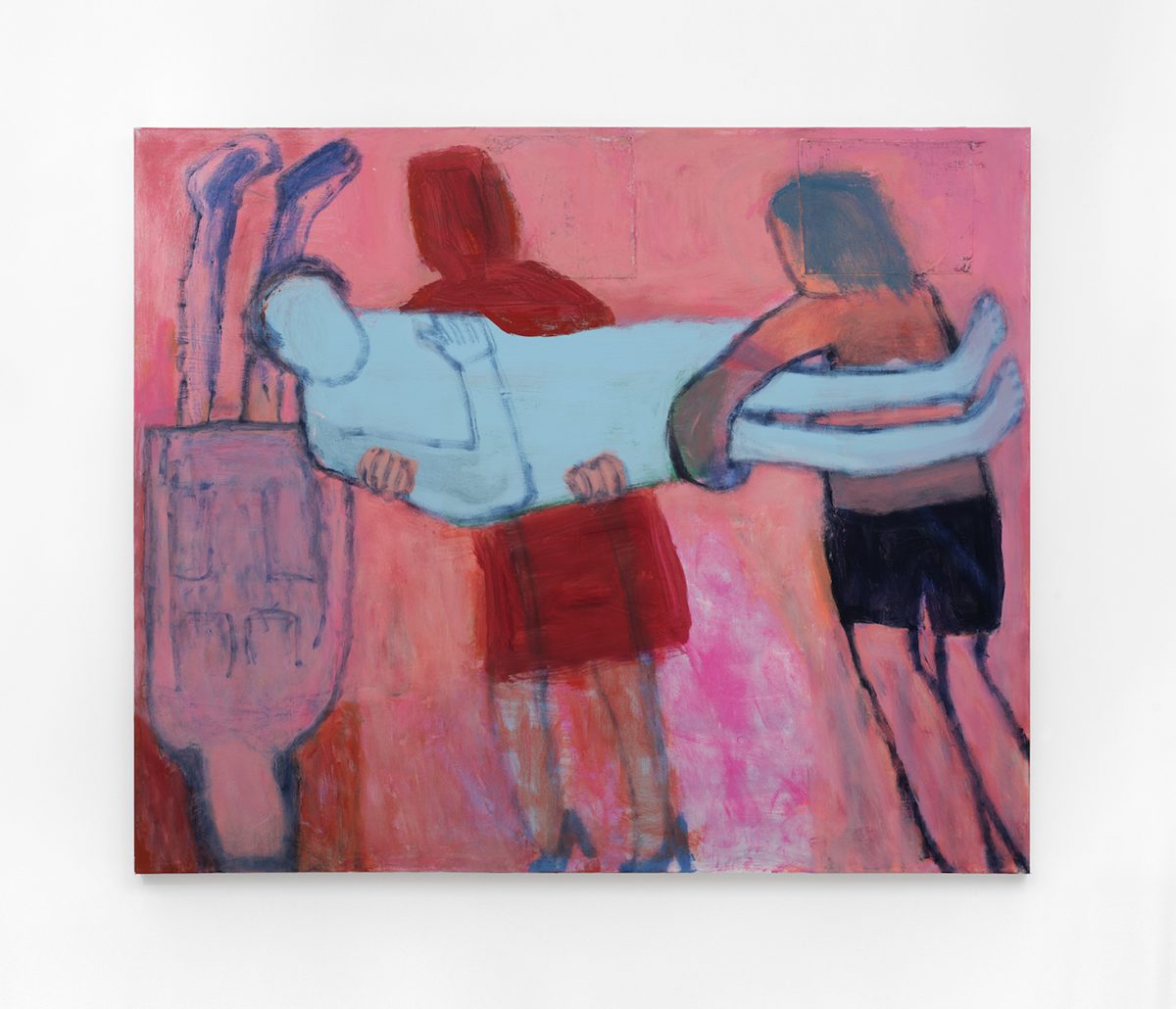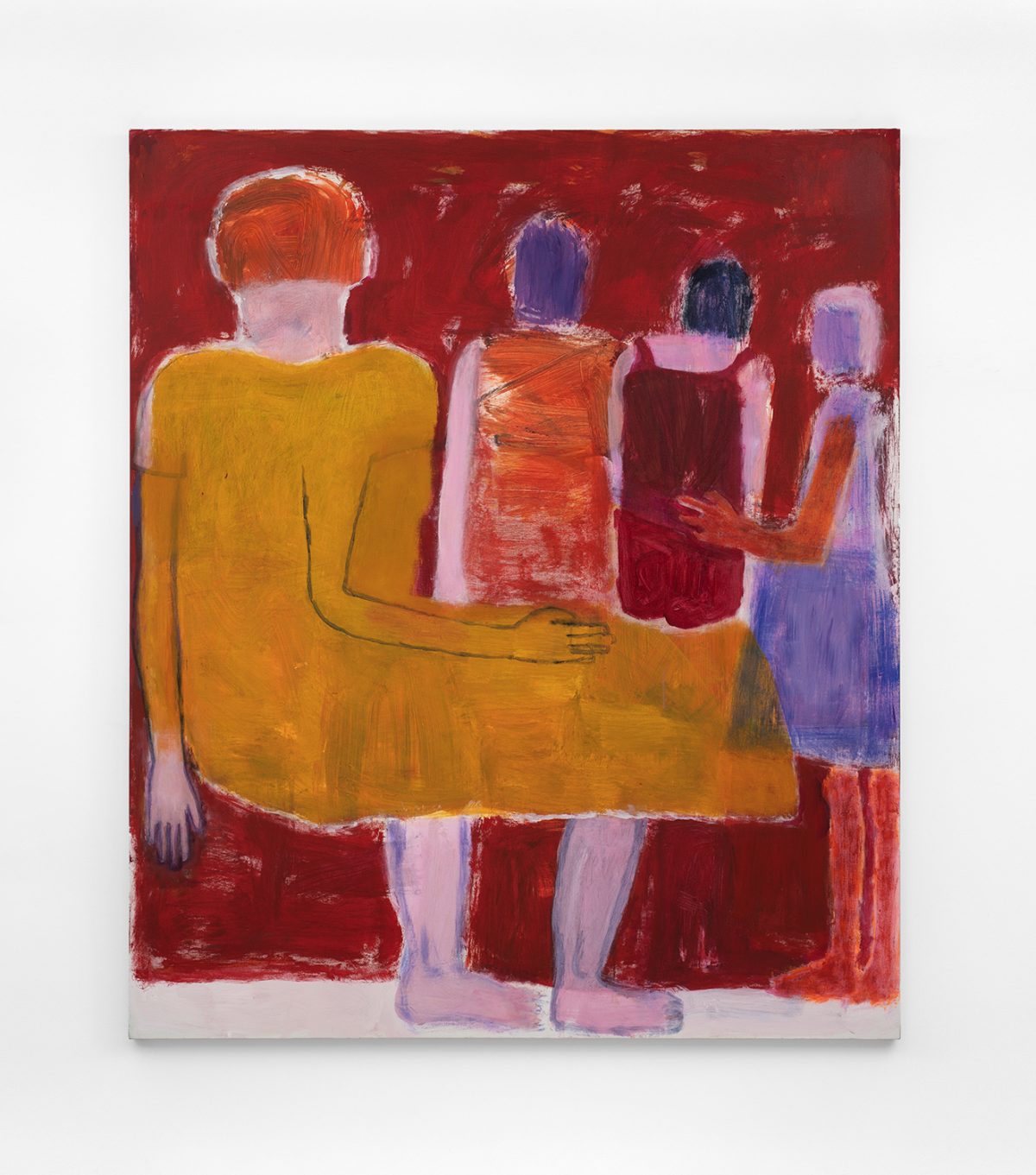
Katherine Bradford is a painter who has held my attention for more than a decade, and I have written about many of her shows. Still, before I saw her current exhibition, Katherine Bradford: Mother Paintings at Canada (April 15–May 15, 2021), I wondered what more I could say about her work, following an observation I made about her last show at Canada (2018):
Bradford has transformed visual dislocations into the very colors and forms of her compositions, steeping what might initially seem sweet and arbitrary in sadness and isolation. What makes this change even more powerful is that the paintings don’t seem to be about Bradford’s interior life. Rather they seem to be about what she sees; they are about us and our despair.
Our collective despair has changed has changed since 2018, largely because of COVID-19, which has caused more than 565,000 officially reported deaths in America.
According to the gallery press release, “as the [show’s] title implies, Bradford explores the idea of Mother as an archetype, a lived experience and state of mind.”
The decision to do a thematic exhibition about the “Mother” archetype in the midst of a deadly pandemic, whose ubiquitous existence many America continue to deny, could have easily become polemical, didactic, exploitative, or self-serving, but this is not the case.

Done in acrylic, the 11 paintings range in size from 48 by 36 inches (“Magenta Free,” 2021) to six paintings measuring 80 by 68 inches. Laying down scumbled, semi-transparent layers of color and often using a dry brush, Bradford works everything out on the canvas; she is a process figurative painter whose drawing is direct and awkward. All but one figure is featureless. Many are defined by a contour line. The palette is luminous and moody, ranging from dirty pinks and creamy white to blackish greens, dark magentas, burnt oranges, and searing reds.
Bradford draws the outlines of her figures against an abstract, often monochromatic ground that brings to mind Mark Rothko’s abstractions. One can glimpse traces of earlier lines and shapes in many of the compositions. In this regard, the paintings are layered palimpsests comprised of hieratic figures that seem to be inspired by Egyptian wall painting and sculptures. Rather than being weighed down by these historical precedents, Bradford transforms them into something all her own, which is remarkable. Moreover, in these paintings, she has defined a liminal space where her observations of life in a pandemic have merged with her interior world.
In “Fear of the Dark” (2020), three seated, scumbled figures are depicted in the lower right-hand corner, largely in profile, starting with the smallest. The feet of the two largest figures rest on a dark magenta band made up of tonally distinct rectangles, while the smallest figure’s feet dip into the semi-transparent band, as if soaking in red wine. Above them, floating in the deep violet sky, we see different, darkly glowing, irregularly shaped orbs, some blue or gray over a larger pink orb. Although floating serenely in the night sky, they are large and numerous enough to convey why the smaller figures might feel apprehension.

“Fear of the Dark” invites us to speculate on what the larger figure is saying to comfort the two small ones, who are listening attentively. How do you allay someone’s fear? What can you say that will make them feel safe? This is just one of the interactions evoking a mother and child that Bradford gets to in this quietly moving exhibition.
In “Mother’s Lap” (2020), Bradford depicts four figures seen from behind, against a hot red ground. The orange-umber body of the largest, the mother figure, who is on the painting’s left edge, forms an L shape, her torso parallel to the painting’s left edge, her thick lower body stretching nearly to the right edge. A thin figure in a pale violet skirt who stands alongside the painting’s right edge, her arm and hand also forming an L, seems to steady one of the two figures seated on the mother’s lap.
Proportionally, the size of the three figures suggests they are not young children; they could be young adults. The mother’s lap is big enough to accommodate only two of the three large figures. A thin, awkwardly rendered outline of the mother’s right arm extends along her lower body, ready to protect the figure closest to her. Her other arm hangs down by her side, next to the painting’s left edge, as if it cannot help to protect the three figures. All of them are staring into the hot red ground, perhaps to the future, and are open to whatever it brings.
In “Motherhood” (2021), the featureless mother is wearing a dirty-white tank top, violet-stained white pants with cuffs, and bluish-black boots. On the left, her arm extend around a child who kneels on the mother’s lap, and, on the right, it extends around a standing figure in an orange skirt and blue sleeveless blouse. The child’s face is turned toward the viewer, revealing a crudely drawn smile and two marks for eyes.

The mother’s clothes undermine conventional images of the loving and protective mother, which have been circulating in our society for far too long. This is just one of the many ways that Bradford subtly challenges the conformist thinking that is pervasive throughout America.
In the large, pink and red painting “Mother Joins the Circus – Second Version” (2021), two women carry a pale turquoise body toward an inverted female figure on the far left. Why is she upside down, balanced on her head? Who is the prone figure? Why is one woman, who is mostly a dark red, featureless silhouette, wearing blue high heels? What is the relationship of the painting’s title to its content?
“Fever” (2021) is split into two views, aerial in the upper half and frontal in the lower. Both views are cropped; in the lower half two orange arms extend in from the right edge, their hands massaging the bare back of a bald man, facing downward and seen in profile. In the painting’s upper half, a bare arm extends stiffly down from the top edge until the hand rests on the feverish red-orange forehead of a featureless figure. It is one thing to read the statistic of how many have died from or been afflicted by COVID-19, but another to witness it in a hospital. The presence of the arms, and the fact that we cannot see who they belong to, strikes so many different parts of our consciousness, from fear of contagion to the anonymity of so many brave heath workers.

In “Upsetting Times” (2020), three separate figures each occupy their own space. There is a large seated figure in profile, on the right edge; a ghostly white figure in the shape of an inverted L; and a woman defined by areas of deep purple, violet, and magenta, her dark violet hands crossed at the wrists, her finger spread apart and and extending out, like wings.
The woman’s face is solid purple. We cannot see her expression nor know what she is feeling. The floating, disembodied hands — and the feeling of disconnectedness they evoke — convey a sense of the grief and helplessness that she feels.
It is arrogant to say you feel someone’s pain. It is something quite different to recognize that, no matter how sympathetic we are, we will never actually know what another person has felt. Bradford’s paintings touch on so many feelings, as her different visions of the mother — who is protective, stoic, tender, powerful, and vulnerable — remind us of what we have collectively and individually endured, not only during the past year but for more years than the pandemic has been with us.
Katherine Bradford: Mother Paintings continues at Canada (60 Lispenard Street, Manhattan) through May 15.
0 Commentaires